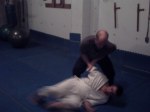The Virginia FSRI group has been learning this throw (basic hip spiral/o-goshi) and reviewing falling skills for the last few weeks. The clip shows some different semi-open randori exchanges designed to integrate it with related pin/escape skills. Continual role switching makes it a bit more challenging and dynamic, but within an environment that’s still conducive to some experimentation (from the 4/7 VA class).
FSRI Contributors:
- Gillian Russell
- David Chopper Campbell
- kevinpreilly
- Randy Simpson, M.S.
- Robert Miller CPT CES PES
-
Recent Posts
Anatomy Resources
Blogroll
DIY Training Equipment
FSRI Clubs
FSRI Original Research
- More on Perception: Don't Just Rely on Visual Input
- Change Blindness and it's Relationship to Training
- Applying Sports Science to the Fighting Arts
- Bernard Bettelheim: The Misadventures of a Missionary in 18th Century Okinawa
- Evidence Based Practice in the Fighting Arts: Appraisal and Suggestions
- Understanding Karate by De-emphasizing Kata
- More on Rhabdomyolysis and the Fighting Arts
- Epistemic Viciousness in the Martial Arts
FSRI Training/Teaching Resources
- Regarding hurdler's Stretches and Kicking
- Back Brief
- Injury Comeback Story: complete ACL tear (part 1)
- A Brief Discussion on the Relativity of Skills
- Basic Thoracic Spine Injury Prevention for Fighting Arts & Combat Sports
- Using the Overhead Squat Assessment to Identify Reductions in Punching Quality
- Getting More out of your Heavy Bag
- Knee Osteoarthritis in the Fighting Arts and Combat Sports
- Hip Flexor Stretches
- Vertebral Artery and Carotid Artery Dissection Resulting From Mild Neck Trauma
Mugs and T-shirts
Recommended Fighting Arts
Recommended Trainers
Research Resources
- Google Books
- Journal of Combative Sport
- Journal of Athletic Training
- PubMed
- Journal of Sports Science and Medicine
- Athletic Insight: The Online Journal of Sport Psychology
- Google Scholar
- Dept. of Justice Violent Crime Stats
- InYo:The Journal of Alternative Perspectives on the Martial Arts and Sciences
- The British Journal of Sports Medicine
Resources for Women Dealing with Violence
- Domestic Violence Agencies on the Internet
- "911 for Women" Links Page for the Feminist Majority Foundation
- National Coalition Against Domestic Violence
- Violence against women related resources at feminist.com
- Domestic Violence and Abuse: Help, Treatment, Intervention, and Prevention at Helpguide.org
Strength & Conditioning Resources
- Ex Rx
- National Academy of Sports Medicine
- National Exercise & Sports Trainers Association
- Fitness for the Fighting Arts
- Beast Skills Tutorials
- ACL Injury Prevention for Female Athletes (PEP Program)
- Link Related to the Q Angle
- Stumptuous
- Female Athletes and Serious Knee Injuries
- Sports Fitness Advisor
Useful Misc. Links
Past Articles:












 are available here.
are available here.